Drought-tolerant landscaping ideas – 8 solutions for a more sustainable backyard design
It's goodbye to water-guzzling lawns and needy plants and hello to drought-tolerant varieties and permeable hardscaping
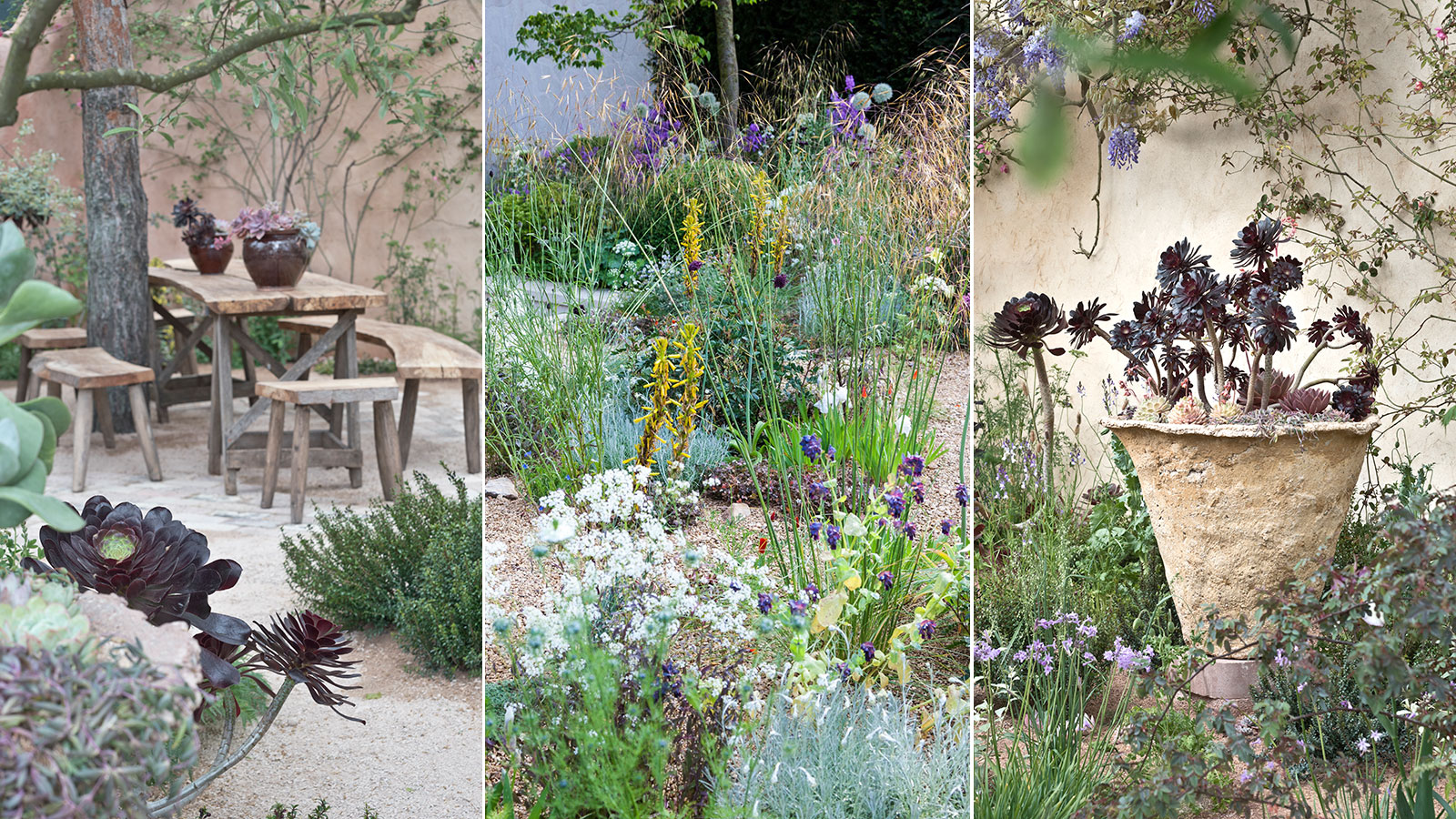

Drought-tolerant landscaping is top of the agenda right now, with the availability of low-water landscaping rebates, lawn-to-garden conversion incentives, and irrigation grants meaning there's never been a better time to redesign your landscape using a more sustainable approach.
A landscape that has been designed with drought tolerance in mind will include a mix of hardscape elements like gravel, river stones, and permeable paving, together with plants, shrubs and trees that are native to your area and don't need frequent watering. Additionally, it will feature 'smart' irrigation such as water-saving devices, rainwater harvesting and gray water systems.
Maybe you're concerned about drought in your area or perhaps it's a case of opting for drought tolerant planting ideas as you no longer want to spend time watering your yard every day. Either way, find out what the experts have to say about drought-tolerant landscaping and what you can learn about making your own backyard more climate friendly.
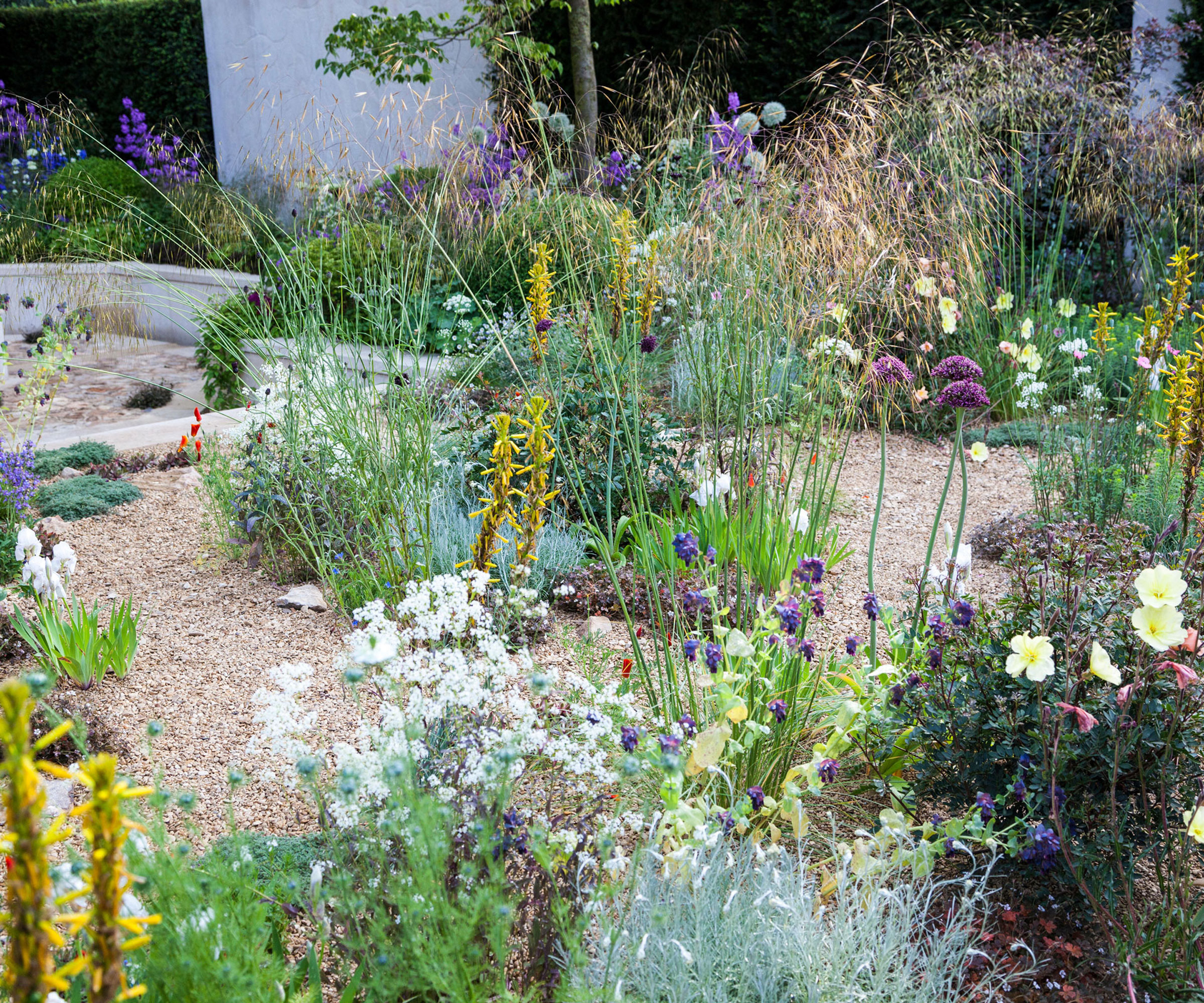
Ornamental grasses and gravel interspersed with long flowering perennials is an easy formula to remember for a drought-tolerant landscaping
Cut down on water usage with these drought-tolerant landscaping ideas
'In the face of climate change and increasing water scarcity, it's crucial to make sustainable choices for our gardens,' says Andrew Laurier, gardening expert at Be.Green. 'By selecting drought-tolerant native plants and trees, we can create beautiful, resilient landscapes that conserve water and support local ecosystems.'
If in doubt about plants or any other aspect of drought-tolerant backyard ideas, it's a good idea to consult local nurseries, your local extension service, horticultural experts, or landscape professionals who have knowledge of the conditions in your region, and can provide invaluable advice.
1. Choose drought-resistant native plants
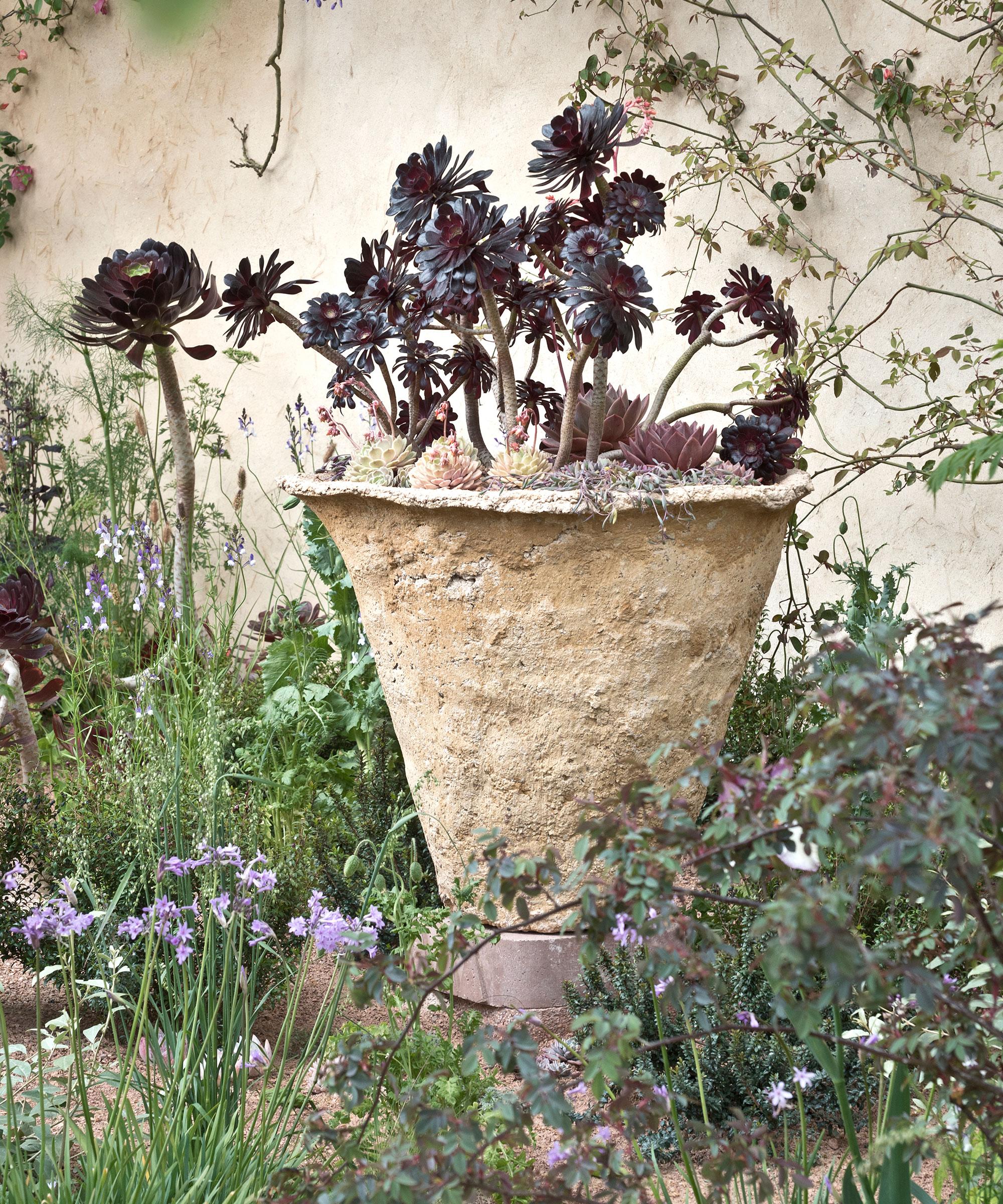
Aeoniums, agave, aloe and other varieties of cacti and succulent all thrive in drought-tolerant landscaping design
Native plants are a great choice for drought-resistant landscaping as they're adapted to the local climate and need less water once established. 'Depending on the zone, native plants will vary but some popular drought-tolerant options include succulents like agave and yucca, ornamental grasses such as feather reed grass and blue fescue, and flowering perennials like lavender and coneflowers,' says Kevi Tara, owner of plant nursery LeafnJoy. Once established, plants like Elijah Blue Fescue (available from Nature Hills) require limited water.
When choosing native drought-tolerant shrubs and plants, first look around your local area and see what's thriving. 'Even better if you can find an unmaintained plot of land,' suggests landscape and permaculture designer Samuil Iliev. 'There you will find the toughest plants. Most of them will be considered weeds, but a few will catch your attention. You can use one of the many apps that offer plant identification, then search for a local nursery that offers that plant or its seeds.'
Low water bunch grasses, such as Carex pansa, are easy to take care of, and incredibly versatile. 'They sway beautifully in the breeze too,' says California-based Camille Cimino, landscape designer at The Nature of Things Design. 'Other good choices include aloe, agave, and phormium tenax, which come in a variety of colors and have striking shapes.'
2. Make good use of mulching to retain moisture
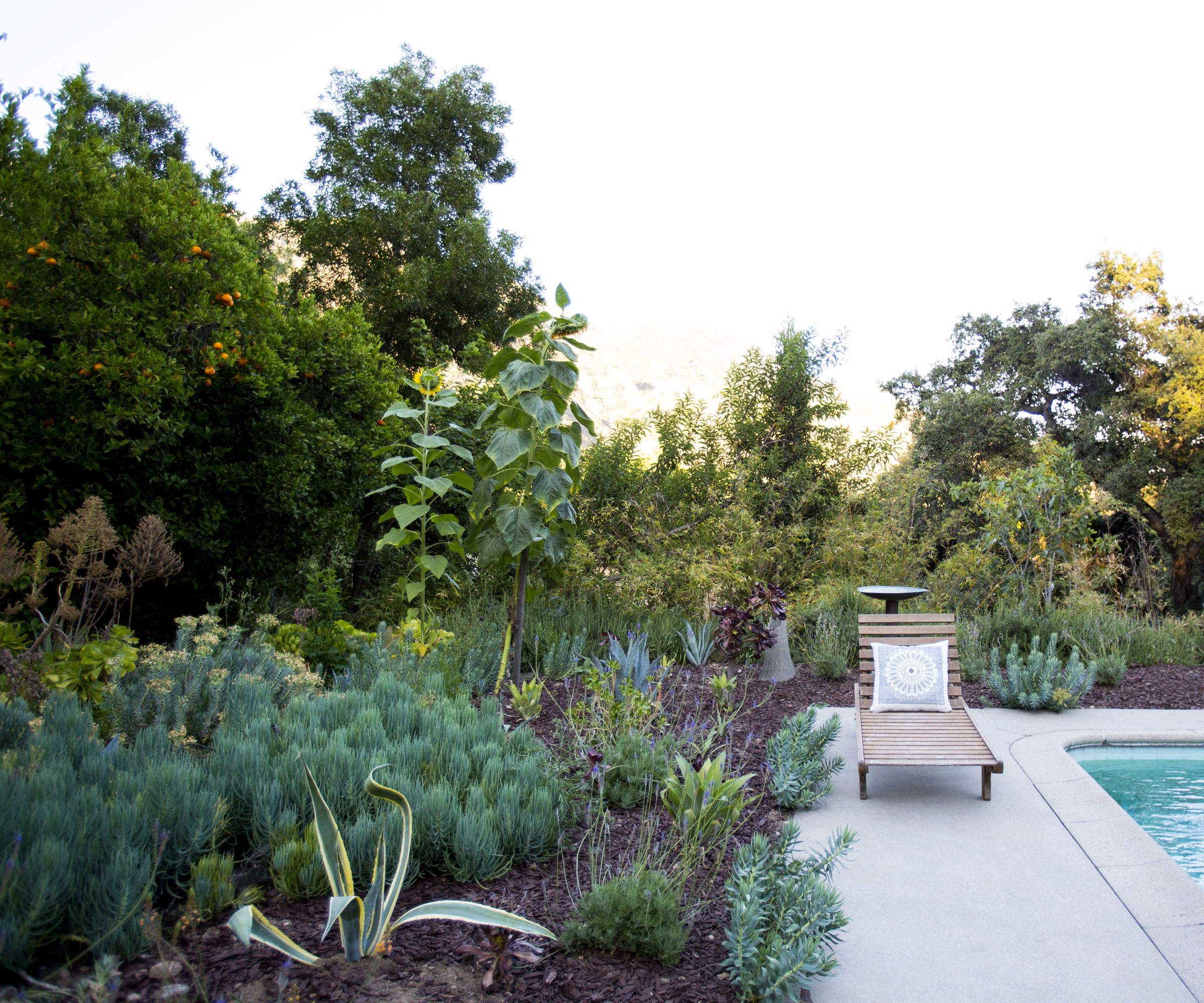
The planting beds in this Californian yard are layered in mulch to help the soil retain moisture
Bare soil is vulnerable to erosion, the seeds of weeds take root and it leads to water waste, but mulching has benefits that counteract all these. There are many types of mulch available and the main rule is 'the more the better'.
'Most tree trimming companies are happy to give away truckloads of perfectly good mulch,' says Kate Russell, author of Stop Wasting Your Yard! (available on Amazon) and founder of The Daily Garden. 'Coarse wood chips are ideal. They break down slowly, improving soil structure and feeding the soil micro-organisms that make plant life possible.'
Add a thick layer of mulch to the surface of the soil and it will act like a sponge to soak up any rainwater then hold it in the soil. This means it's a real asset for drought-tolerant landscaping ideas.
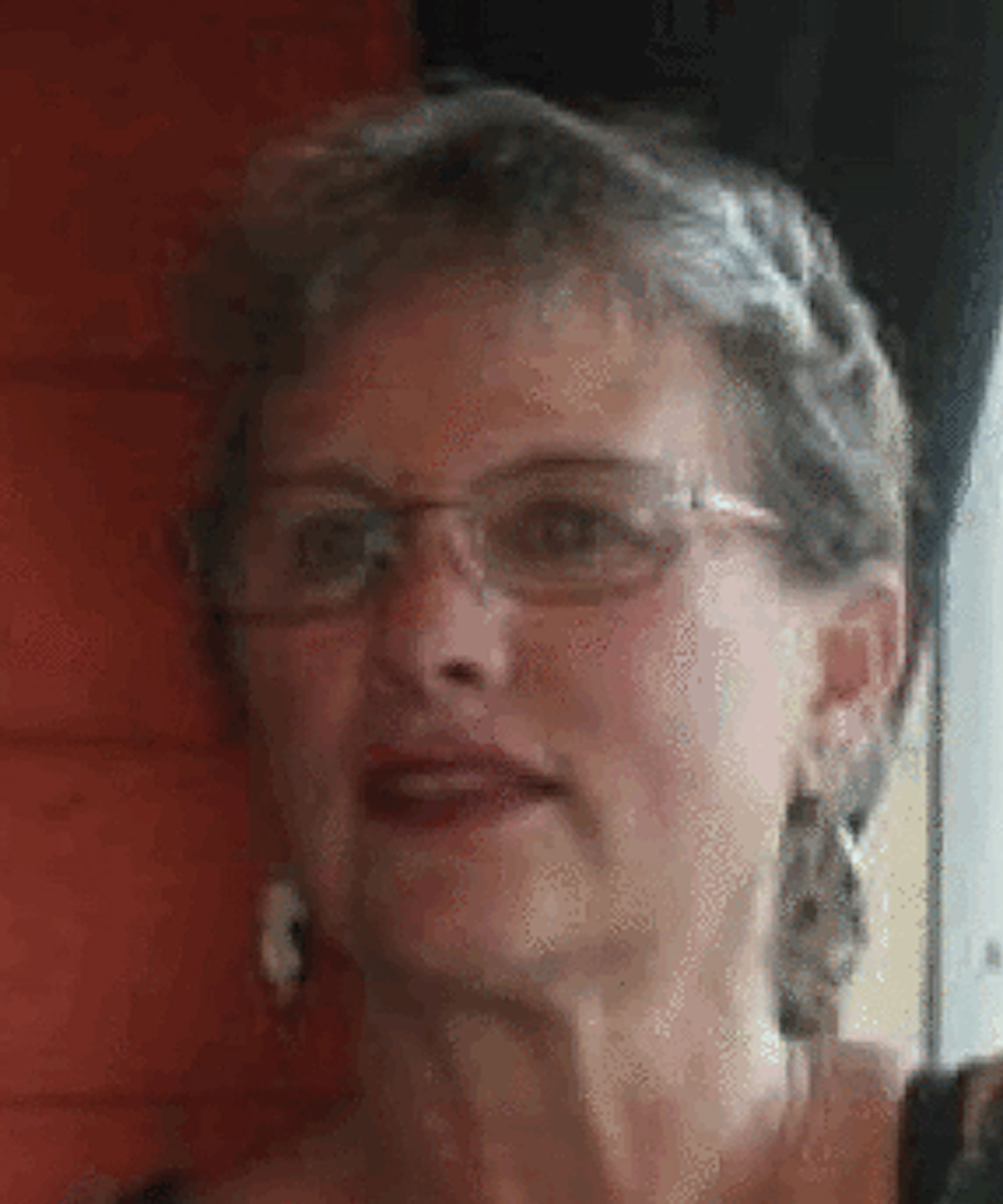
Kate Russell teaches how to make the most of a landscape by incorporating delicious, attractive edible plants. She published Stop Wasting Your Yard!, and has been quoted by The Washington Post and USA Today. As a former California County Extension volunteer, Kate helped design and install an educational garden at Martial Cottle Park in San Jose, CA. She writes extensively on science-based gardening in her blog, as well as for botanical societies and print media.
3. Mix up your hard landscaping options
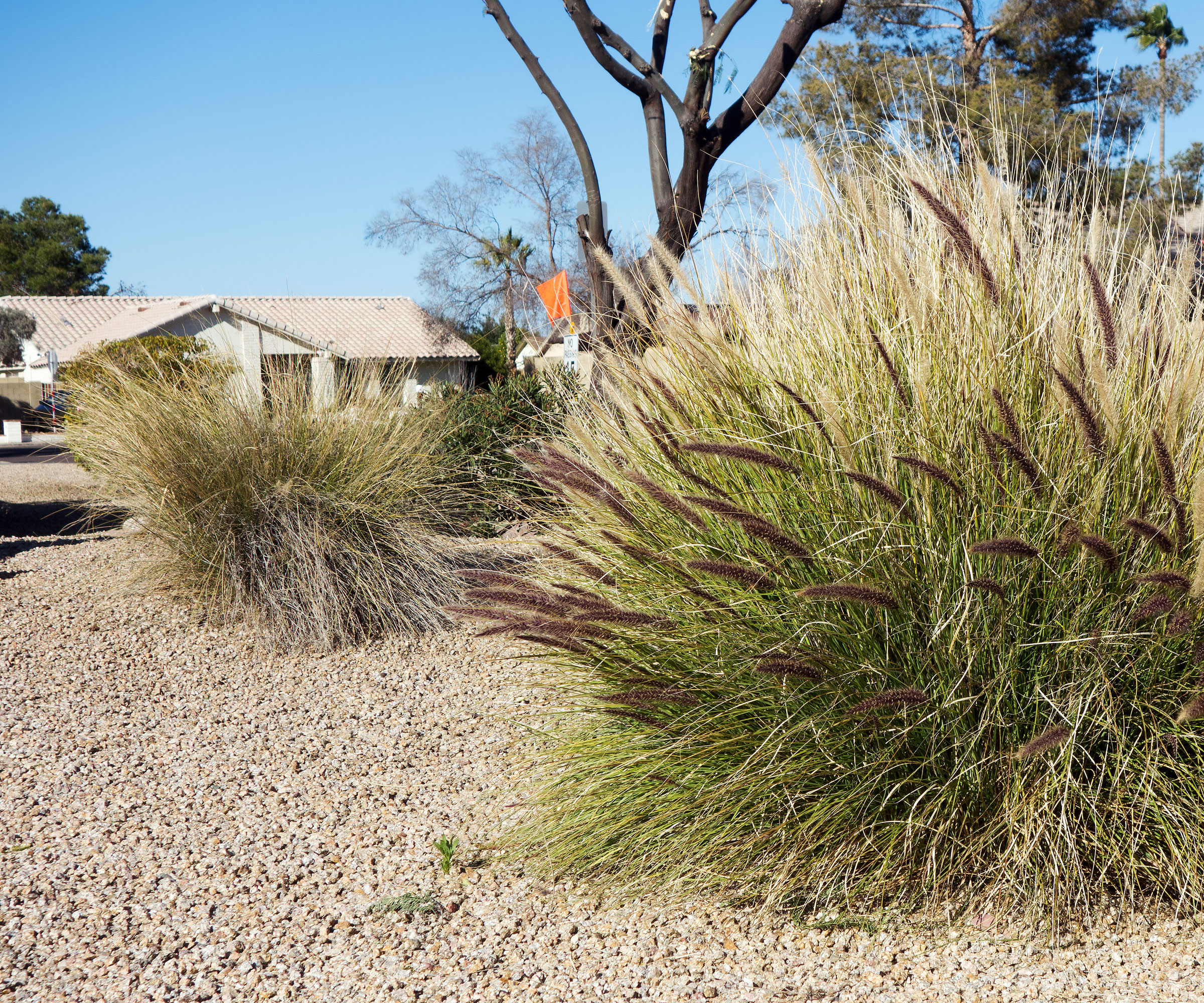
There are lots of permeable hardscaping options to choose from but gravel is always a good starting point (especially when paired with Fountain Grass like here) as it's affordable and can be used in so many different ways
Things that are authentic to place feel right, whether it’s native plants or hardscaping. Choose permeable hardscaping as the natural partner to drought-tolerant planting ideas.
'For paths and rustic patios, local pea gravel is a chic, inexpensive, and eco-conscious choice,' says Heather Evans, master gardener and author of the Substack column Dear Avant Gardener. 'It lets rain run through, keeping much-needed water on your property.' Heather uses the local yellow-white limestone pea gravel in her yard in Florida.
Sarah Gill is a garden expert and landscaper at Hypedome. She is also a fan of gravel garden ideas for reducing water runoff and promoting better water infiltration as a key element of drought-tolerant landscaping.
'I also like decomposed granite, a crushed rock material that compacts well and provides a stable surface for paths and patios,' says Sarah. 'Decomposed granite allows water to infiltrate into the soil while providing a firm and durable surface. It can be used alone or with other hardscaping materials for added visual interest.'
You can also use river gravel, lava rocks, pumice, and even crushed concrete as a decorative accent in your drought-tolerant landscaping.
4. Opt for clever water management solutions
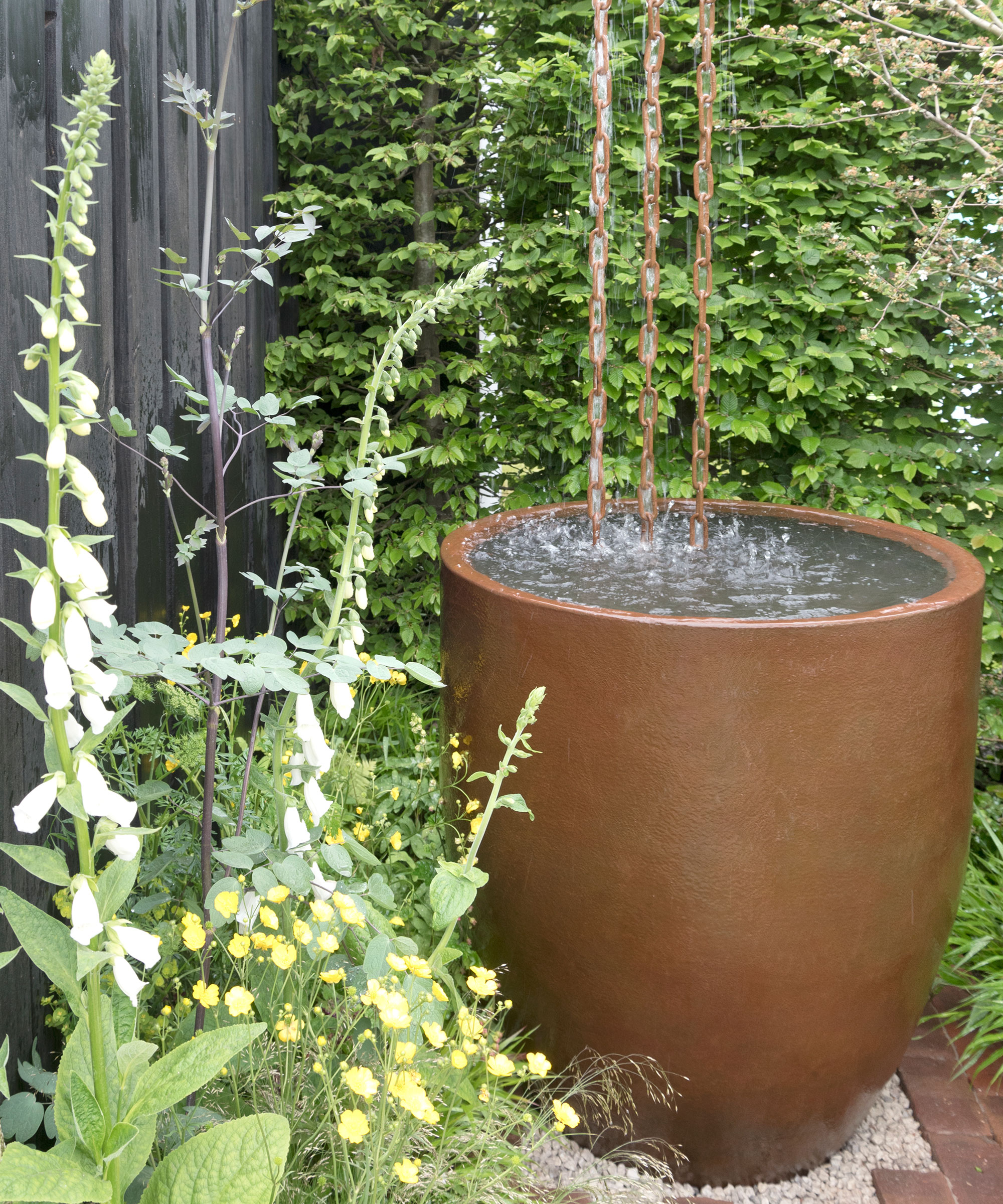
Capturing rainwater is a must for any drought-tolerant landscaping design
For drought-tolerant landscaping to survive and thrive you need to be able to save and collect as much water as possible. Water plants deeply but less frequently, which uses less water and puts water where a plant most needs it, which is at the roots. Remember that not all plants need the same amount of water, and to minimize evaporation avoid the common garden watering mistake of watering during the hottest parts of the day.
In addition to mulching, try drip irrigation and rainwater harvesting. Making a rain barrel and combining it with rain chains can help you to maximize the amount of water you can collect.
'If you can set up rain barrels and collect your rainwater it is always a good thing. Try to capture as much water as possible,' says Kody J Ketterling, professional landscaper and owner of KJ Enterprises, who is based in Twin Falls, Idaho. 'Any time you can catch water you are helping to give plants and soil a cooling effect.'
5. Reduce your lawn area (or get rid of it)
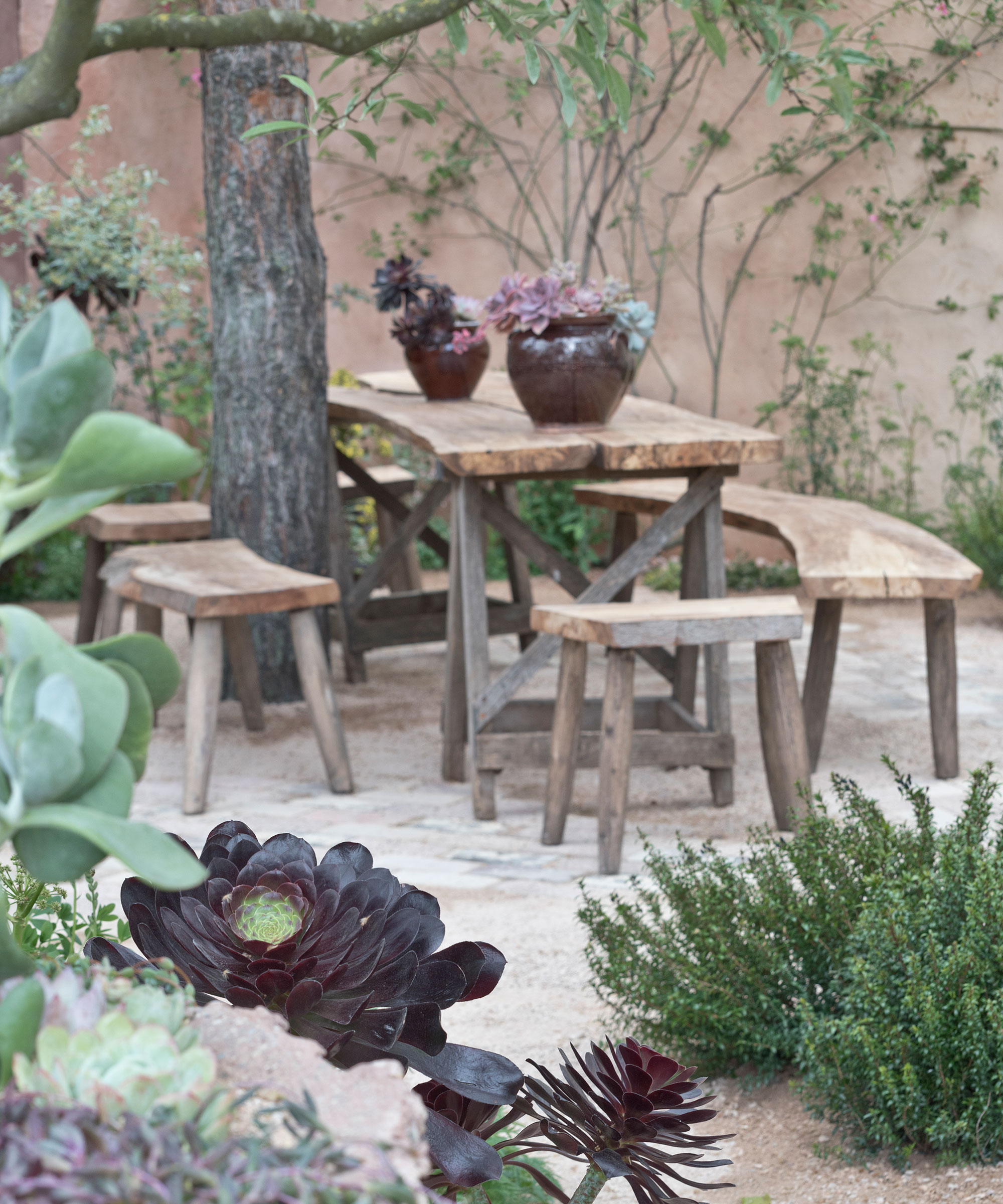
Designed by Sarah Price Landscapes, this space shows that going lawn-free can make for more interesting use of outdoor space
Another way to decrease water consumption is to either go lawn free or reduce the size of your lawn area. Popular conversion ideas include mixes of drought-resistant plants and permeable hardscaping.
'The traditional golf-course style lawn is out,' says Camille Cimino. 'It takes a ton of water, weekly mowing, and annual fertilizing. You can still create inviting spaces to stroll, play or gather in, by using gravel or mulch surrounded with greenery.'
The no grass backyard trend is really gathering pace, and is particularly popular among fans of rewilding. 'I started the process of introducing native plants by allowing my lawn to become a meadow,' says Kate Russell. 'The results were delightful. First, nearly all the work was eliminated. Once my meadow was established, I didn’t have to water, weed, mow, or aerate it. I could just sit back and enjoy watching all the butterflies, birds, and other critters attracted to my new offering.'
6. Plant a drought-tolerant native tree or two

This gorgeous palo verde tree is covered in masses of yellow flowers in spring
By selecting drought-tolerant native trees that are well-suited to your climate, it's easy to create a beautiful, resilient landscape that conserves water and supports local ecosystems. It's also beneficial for wildlife garden ideas.
'We need more trees for shade in a warming world,' says Heather Evans. 'Native trees that evolved in your area will be best suited to its climate, including periods of drought. I love small, flowering trees because almost anyone can fit them into their yards, they nourish birds and pollinators, and they look gorgeous.'
Heather's favorite drought-tolerant flowering trees for a small garden are native to most of the US: serviceberry, American dogwood, Chickasaw plum (native to the Southeast) and chokecherry. 'Native plums and cherries are keystone species,' she adds, 'hosting about 400 butterfly and moth caterpillars – the primary food of nesting birds.'
One of Andrew Laurier's favorites is the palo verde tree. 'With its green trunk and bright yellow flowers, it's a drought-tolerant marvel,' he says. 'Native to the desert regions, it has evolved to withstand harsh conditions. Its canopy offers dappled shade while the flowers attract pollinators, helping to support local biodiversity.'
7. Hardscape with drought-friendly ground cover
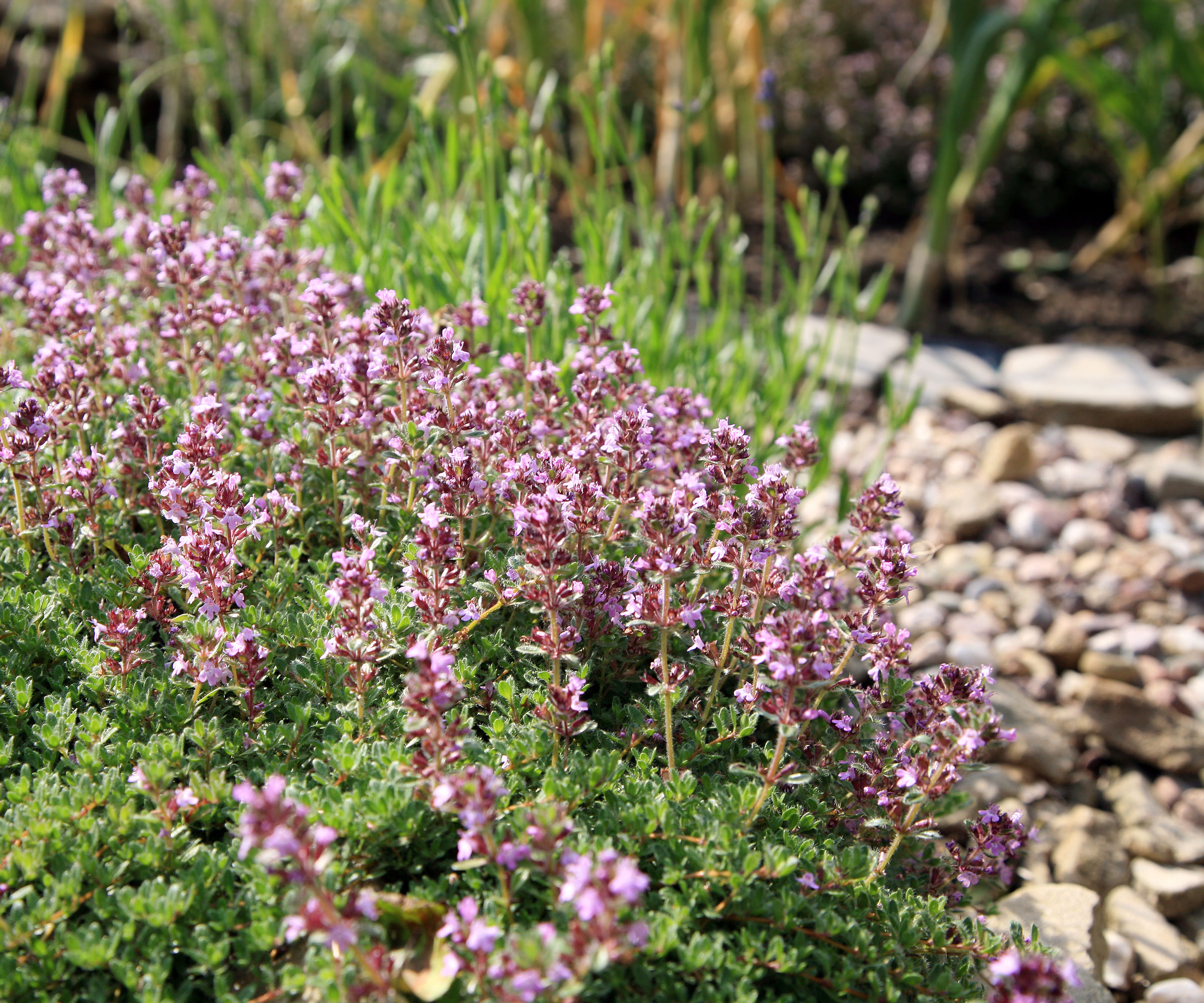
Pockets of creeping thyme are a great choice for pairing with gravel, pebbles and rocks
Hardscaping with plants can enhance the beauty and functionality of outdoor spaces. By combining hardscaping with the best ground cover plants, you can add visual appeal while also conserving water.
'Create charming pathways and walkways by bordering them with low-growing ground covers such as creeping thyme or sedum, which can withstand foot traffic and release a pleasant aroma as you pass by,' says Brock Ingham, founder of Bigger Garden. 'Try integrating pockets of planting into crevices in retaining walls.' You could even consider replacing a lawn with walkable ground cover plants too.
Brock also suggests pairing rock gardens with drought-tolerant varieties like ice plants, blue fescue, or sedum to create an eye-catching display of texture and color.

Brock has been gardening and landscaping now for over a decade. From creating rock gardens to adding to his never-ending list of no-mow ground covers, he shares his passion for gardening with anyone who will listen.
8. Try edible xeriscaping

The good news is pomegranates don't need a lot of water
'Having lived in California for much of my life, drought has always been part of my garden and landscape plans,' says Kate Russell. 'Most edible plants need far more water than would ordinarily be used in xeriscaping, but not all.'
Vegetables including pole beans, garlic, and onions, as well as herbs and mustard greens, and fruit such as figs, grapes and pomegranates all make it onto Kate's shortlist for edible xeriscaping plants. While these plants need some irrigation, especially as they are getting established, these drought-tolerant vegetables should be able to provide you with edible crops using far less water than other traditional garden crops. Also known as dryland farming, this method uses plants that have evolved to use water stored in the soil from the previous winter’s rainfall.
'Identify moisture spots, such as downspouts and low areas suitable to plants that need more water,' recommends Kate. 'Identify how much sun each area gets throughout the day and over the seasons. Color-coding these areas can help you place your plants based on sun exposure needs.'
When it comes to drought tolerant landscaping, anything you can do to retain as much water as possible is going to be of benefit to your plants. 'Any soil that is exposed to the sun will dry out quicker and will expand your heat zone and take longer to replenish with water,' says Kody J Ketterling. 'So if you can cover the ground you give the soil an opportunity to retain more moisture which in turn will reduce the amount of water needed for plants.'
Sign up to the Homes & Gardens newsletter
Design expertise in your inbox – from inspiring decorating ideas and beautiful celebrity homes to practical gardening advice and shopping round-ups.
Lifestyle journalist Sarah Wilson writes about flowers, plants, garden design and gardening trends for Homes & Gardens. She has studied introductory garden and landscape design and floristry, and also has an RHS Level 2 qualification in the Principles of Plant Growth and Development. She is a regular contributor to Homes & Gardens and Livingetc. She has also written for Real Homes, Modern Gardens and Country Homes & Interiors magazines.
-
 Thoughtful modernism – how one Dallas home makes bold contemporary design feel warm, welcoming, and comfortable
Thoughtful modernism – how one Dallas home makes bold contemporary design feel warm, welcoming, and comfortableWith its mix of textural finishes and carefully curated furnishings, this modernist home is a refreshing retreat
By Karen Darlow Published
-
 'Wick away the ick' – 6 things people with clean laundry rooms always do to make this hardworking space shine
'Wick away the ick' – 6 things people with clean laundry rooms always do to make this hardworking space shineThese tips on how to clean your laundry room will banish grime
By Seraphina Di Mizzurati Published